
Concept explainers
(a)
Interpretation:
The number of neutrons in an atom of
Concept introduction:
The
Answer to Problem 21E
The number of neutrons in atom of
Explanation of Solution
The mass number of
The number of neutrons is calculated by the formula shown below.
Substitute the values of mass number and atomic number in the above equation.
Thus, the number of neutrons in atom of
The number of neutrons in an atom of
(b)
Interpretation:
The number of neutrons in an atom of
Concept introduction:
The atomic number of an atom is equal to the number of protons in an atom. Mass number or atomic mass of an atom can be calculated by taking the sum of atomic number and number of neutrons.
Answer to Problem 21E
The number of neutrons in an atom of
Explanation of Solution
The mass number of
The number of neutrons is calculated by the formula shown below.
Substitute the values of mass number and atomic number in the above equation.
Thus, the number of neutrons in atom of
The number of neutrons in an atom of
(c)
Interpretation:
The number of neutrons in an atom of
Concept introduction:
The atomic number of an atom is equal to the number of protons in an atom. Mass number or atomic mass of an atom can be calculated by taking the sum of atomic number and number of neutrons.
Answer to Problem 21E
The number of neutrons in an atom of
Explanation of Solution
The mass number of
The number of neutrons is calculated by the formula shown below.
Substitute the values of mass number and atomic number in the above equation.
Thus, the number of neutrons in atom of
The number of neutrons in an atom of
(d)
Interpretation:
The number of neutrons in an atom of
Concept introduction:
The atomic number of an atom is equal to the number of protons in an atom. Mass number or atomic mass of an atom can be calculated by taking the sum of atomic number and number of neutrons.
Answer to Problem 21E
The number of neutrons in an atom of
Explanation of Solution
The mass number of
The number of neutrons is calculated by the formula shown below.
Substitute the values of mass number and atomic number in the above equation.
Thus, the number of neutrons in an atom of
The number of neutrons in an atom of
Want to see more full solutions like this?
Chapter 4 Solutions
EBK INTRODUCTORY CHEMISTRY
- How is an atom’s atomic number related to its number ofprotons? To its number of electrons?arrow_forwardThe element lanthanum has two stable isotopes, lanthanum 138 with an atomic mass of 137.9071u and, lanthanum 139 with an atomic mass of 138.9063u. From atomic mass of La, 138.9u what conclusion can you make about the relative percentage abundance of the isotopes?arrow_forwardHow do isotopes of a given element differ? How are they similar?arrow_forward
- Naturally occurring aluminum has a single isotope. Determine the following for the naturally occurring atoms of aluminum: a. The number of neutrons in the nucleus. b. The mass in u of the nucleus to three significant figures.arrow_forwardNaturally occurring sodium has a single isotope. Determine the following for the naturally occurring atoms of sodium: a. The number of neutrons in the nucleus. b. The mass in u of the nucleus to three significant figures.arrow_forward
- Chemistry: Matter and ChangeChemistryISBN:9780078746376Author:Dinah Zike, Laurel Dingrando, Nicholas Hainen, Cheryl WistromPublisher:Glencoe/McGraw-Hill School Pub Co
 Living By Chemistry: First Edition TextbookChemistryISBN:9781559539418Author:Angelica StacyPublisher:MAC HIGHER
Living By Chemistry: First Edition TextbookChemistryISBN:9781559539418Author:Angelica StacyPublisher:MAC HIGHER World of Chemistry, 3rd editionChemistryISBN:9781133109655Author:Steven S. Zumdahl, Susan L. Zumdahl, Donald J. DeCostePublisher:Brooks / Cole / Cengage Learning
World of Chemistry, 3rd editionChemistryISBN:9781133109655Author:Steven S. Zumdahl, Susan L. Zumdahl, Donald J. DeCostePublisher:Brooks / Cole / Cengage Learning  Introductory Chemistry: An Active Learning Approa...ChemistryISBN:9781305079250Author:Mark S. Cracolice, Ed PetersPublisher:Cengage Learning
Introductory Chemistry: An Active Learning Approa...ChemistryISBN:9781305079250Author:Mark S. Cracolice, Ed PetersPublisher:Cengage Learning World of ChemistryChemistryISBN:9780618562763Author:Steven S. ZumdahlPublisher:Houghton Mifflin College Div
World of ChemistryChemistryISBN:9780618562763Author:Steven S. ZumdahlPublisher:Houghton Mifflin College Div Chemistry for Today: General, Organic, and Bioche...ChemistryISBN:9781305960060Author:Spencer L. Seager, Michael R. Slabaugh, Maren S. HansenPublisher:Cengage Learning
Chemistry for Today: General, Organic, and Bioche...ChemistryISBN:9781305960060Author:Spencer L. Seager, Michael R. Slabaugh, Maren S. HansenPublisher:Cengage Learning





